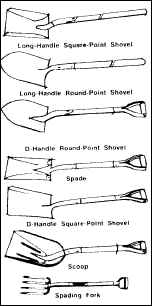SHOVELS
 Shovels are classified by construction, by point description or by handle length.
Shovels are classified by construction, by point description or by handle length.
The five kinds of construction are:
Solid-shank blade and socket – hot rolled from one piece of metal with solid steel section at base of socket.
Plain back (strap socket) – hot formed with two straps holding handle to back by welding.
Closed back – hot formed from sheet steel with extra piece of steel welded to back at base of socket.
Hollow back (open back) – hot formed from sheet steel with opening at base of socket; may have turned or rolled steps for extra rigidity.
Special construction – hot formed from hot-rolled blanks of different gauges depending on end use; offer maximum strength and light weight.
Shovel blades are round or square point and handles are long (48″) or “D” (27″). Those basic for do-it-your self sales include:
Long handled round point – blade and front strap are forged or hot-formed as a single unit. Quality shovels are made of chrome nickel alloy steel while less expensive shovels are carbon steel. Many have rolled or turned foot pedal on top of blade.
Long handled square point – construction and quality features similar to long handled, round point. A square-point shovel has less cutting power than round point and is used for scooping and removing materials.
“D” handled round point – recommended for ordinary garden digging jobs. Quality features are similar to long-handled round-point shovel. Available in weights from light to heavy duty.
“D” handled square point – recommended for removal of loose soil and handling light materials such as sand, asphalt, etc., but not for heavy digging. Also available in light and heavy weights.
Handle lengths and blade lifts are important to balance and efficient shoveling. Low-lift blades and irrigating shovels are best for digging and turning soil while regular-lift shovels and scoops are for moving and throwing earth and other materials.
To measure the blade lift, place the shovel flat on the floor. Lift is measured from the floor to the top of the blade.
Quality features for all shovels include heat-treated blade and strong ash handle.
SPADES
Garden spades have square-point blades about 7″ wide and 12″ long with a 28″ “D” handle. Some have a rolled shoulder on the top of the blade so user can apply foot pressure in unusually hard or heavy soil.
Drain spades, also called tiling spades, are used primarily for digging ditches for tile installations. Round-point blades are 5 1/2″ wide, 14″ to 16″ long and handle is 27″ long. Ditching spades have square point blade 6 1/4″ to 6 1/2″ wide and 14″ to 18″ long, 27″ handle and foot pedal. Good for use in heavy soil or rocky surfaces.
SCOOPS
Scoops have deep blades for moving loose or bulky materials and should not be recommended for digging. Most have “D” handles although some are available with long handles.
SPADING FORKS
Spading forks are roll forged from a solid steel bar to produce four sharp tines that enter and turn the soil more easily than a solid blade.
Quality features include firm handle, non-peeling plated steel and smooth finish.
POSTHOLE DIGGERS AND AUGERS
Light-duty posthole diggers are made with blade and handle socket rolled from one piece of metal while heavy-duty diggers have sharp steel blades riveted to a heavy steel frame. In addition to penetrating the ground, diggers remove dirt from the hole.
Augers burrow into soft soil. Some have adjustable yokes which can be locked into position or changed to drill different-sized holes.
SNOW REMOVING TOOLS
Shovels – Basic stock includes steel, aluminum and plastic snow shovels.
Promotionally priced steel shovels have 14″ x 18″ enamel-finished blades with 33″ “D” handles riveted to blades.
Promotionally priced aluminum shovels have medium sockets and steel wear straps (metal strips at the leading edge of the blade) to reinforce 14″ x 18″ blade.
High-quality shovels, both steel and aluminum, have blades no smaller than 15″ x 18″, tempered steel wear straps and ash or heavy gauge metal handles.
Either can have a coating such as silicone to help keep the snow from sticking to the blade.
Plastic shovels are lightweight, with ribbed blocks for extra strength. They shed snow easily and can be lower priced than metal shovels.
Pushers, Scrapers, Rakes – Snow pushers with sharply-curved blades push snow from sidewalks and driveways; they are not designed for lifting and throwing snow.
Roof rakes, with 15′ or 16′ handles, reach up to roofs to pull down heavy snow. Ice scrapers have an 8″ or 9″ sharp blade to break ice from steps and sidewalks.
Check your state and local codes before starting any project. Follow all safety precautions. Information in this document has been furnished by the North American Retail Hardware Association (NRHA) and associated contributors. Every effort has been made to ensure accuracy and safety. Neither NRHA, any contributor nor the retailer can be held responsible for damages or injuries resulting from the use of the information in this document.

